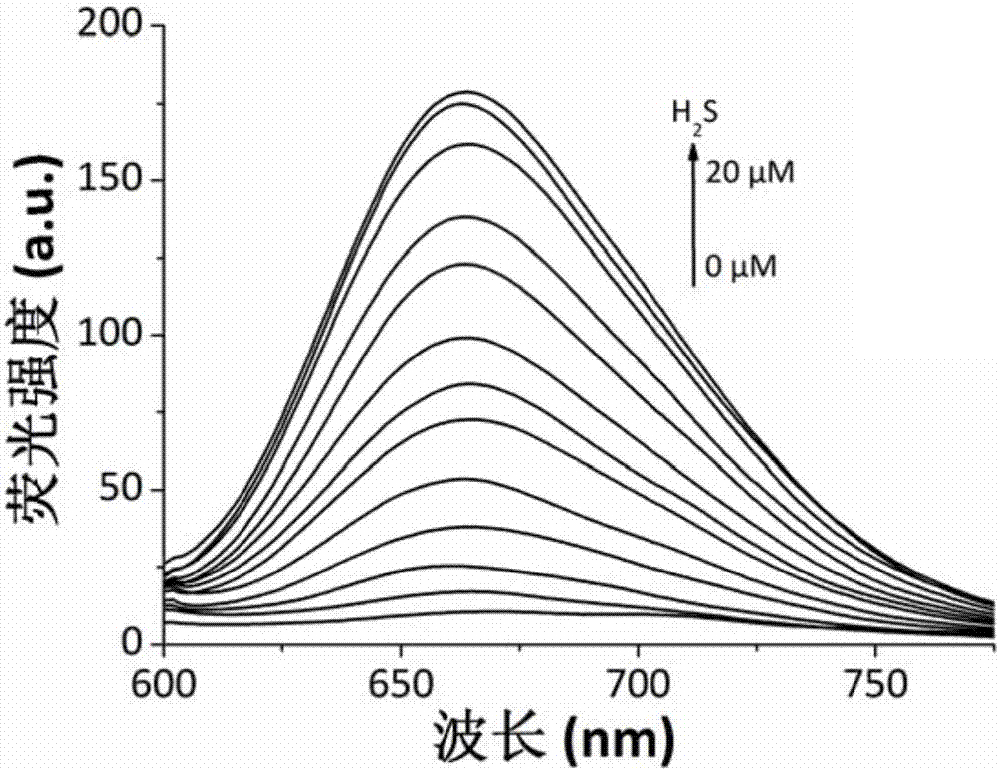Compounding method and application of fluorescent probe for double-channel detection of hydrogen sulfide
A fluorescent probe, hydrogen sulfide technology, applied in the field of synthesis of long-wavelength fluorescent probes, can solve the problems of poor selectivity, complicated measurement operation, high cost, etc., and achieve the effect of good stability and simple preparation method
- Summary
- Abstract
- Description
- Claims
- Application Information
AI Technical Summary
Problems solved by technology
Method used
Image
Examples
Embodiment 1
[0018] Under nitrogen protection, accurately weigh rhodamine compound II (780mg, 1.64mmol), p-hydroxybenzaldehyde (500mg, 1.64mmol), dissolve in 20mL of ethanol, and then add 1 drop of piperidine to the mixture, at 80°C The reaction was stirred at reflux for 10 hours. TLC detected that the reaction was complete, and the reaction was stopped. The solvent was distilled off under reduced pressure, and separated and purified by column chromatography to obtain 1.03 g of a dark green product (Compound I), with a yield of 82.5%. 1 H NMR (400MHz, DMSO-d 6 )δ8.34(s,1H),8.10(d,J=4.0Hz,2H),7.94(d,J=8.0Hz,1H),7.79(t,J=8.0Hz,1H),7.68(t, J=8.0Hz, 2H), 7.34(t, J=12.0Hz, 2H), 6.76(d, J=8.0Hz, 1H), 6.47-6.38(m, 3H), 3.60(q, 4H), 3.37( q,4H),1.78-1.54(m,6H),1.21(t,J=8.0Hz,6H),1.10(t,J=6.0Hz,6H); HR-ESI-MS m / z:[M] +calcd.for663.2620 found 663.2618.
Embodiment 2
[0020] Under nitrogen protection, accurately weigh rhodamine compound II (780mg, 1.64mmol) and p-hydroxybenzaldehyde (500mg, 1.64mmol), dissolve them in 20mL of ethanol, then add 3 drops of piperidine dropwise to the mixture, at 80°C The reaction was stirred at reflux for 6 hours. TLC detected that the reaction was complete, and the reaction was stopped. The solvent was distilled off under reduced pressure, and separated and purified by column chromatography to obtain 1.18 g of a dark green product (Compound I), with a yield of 94.5%.
PUM
 Login to View More
Login to View More Abstract
Description
Claims
Application Information
 Login to View More
Login to View More - R&D Engineer
- R&D Manager
- IP Professional
- Industry Leading Data Capabilities
- Powerful AI technology
- Patent DNA Extraction
Browse by: Latest US Patents, China's latest patents, Technical Efficacy Thesaurus, Application Domain, Technology Topic, Popular Technical Reports.
© 2024 PatSnap. All rights reserved.Legal|Privacy policy|Modern Slavery Act Transparency Statement|Sitemap|About US| Contact US: help@patsnap.com










